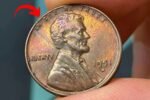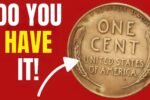These 10 Rare Bicentennial Quarter Are Worth $250 million Each — Still in circulation
Can you imagine finding a quarter that’s worth $250 million? It sounds unbelievable, but according to coin experts, there are 10 rare Bicentennial quarters that could be worth that much — and the most shocking part is, they may still be in circulation. That means these valuable coins could be sitting in someone’s piggy bank, inside a vending machine, or in a pocket full of change right now.
These special quarters were created in 1976 to celebrate 200 years of American independence. While millions of Bicentennial quarters were produced and are still commonly seen, a few rare versions with special features are extremely valuable.
Let’s take a closer look at what makes these coins so rare, why they’re worth so much, and how you might be able to find one.
What is the Bicentennial Quarter?
The Bicentennial Quarter is a special edition of the U.S. 25-cent coin. It was minted in 1975 and 1976 to honor America’s 200th anniversary. The front of the coin (the obverse) still features George Washington, but the back (the reverse) shows a colonial drummer boy with a torch surrounded by stars.
Instead of the usual date, these quarters are marked with “1776–1976” to represent the years of America’s founding and its bicentennial celebration. Most of these quarters are made of copper and nickel and are only worth 25 cents today. But some extremely rare ones are worth millions.
Overview Table: Rare Bicentennial Quarter Facts
| Feature | Details |
|---|---|
| Coin Name | Bicentennial Quarter |
| Year Issued | 1975–1976 |
| Special Marking | “1776–1976” date |
| Design | Drummer boy on reverse |
| Estimated Value (Rare Type) | $250 million each (for 10 known rare ones) |
| Still in Circulation? | Yes, possibly |
| Why Valuable? | Minting errors, silver content, rarity |
Why Are These 10 Quarters Worth $250 Million?
Most Bicentennial quarters are only worth face value. But there are 10 known quarters that are considered extremely rare and highly valuable. These coins are believed to have been made using experimental materials or with unique minting errors.
Here’s why they’re so valuable:
-
Wrong Metal Used: Some quarters were made using silver planchets (blanks), even though most circulating coins were made of copper-nickel.
-
Minting Errors: These rare quarters might have double stamping, off-center strikes, or missing elements, making them unique.
-
Limited Numbers: Only 10 coins like this are known or believed to exist, which adds huge value.
-
Perfect Condition: Some of these coins have never been used in regular transactions, so they remain in mint state condition.
-
Collector Demand: Rare U.S. coins attract collectors from all over the world. A one-of-a-kind coin can create a bidding war and skyrocket in value.
Although these coins were minted nearly 50 years ago, it’s possible they ended up in circulation and haven’t been discovered yet. That’s what makes this story so exciting.
How to Spot a Rare Bicentennial Quarter
Not all 1776–1976 quarters are valuable. To find out if you might have one of the rare ones, look out for the following:
-
Check the Edge: Rare versions may be made of silver. Silver quarters have a solid silver edge instead of a copper stripe.
-
Look for Errors: Use a magnifying glass to check for doubling in letters or numbers, missing details, or strange marks.
-
Check for Weight: Silver quarters weigh slightly more than copper-nickel ones.
-
Look at the Condition: Coins in perfect or near-perfect condition (no scratches, no wear) are worth more.
-
Use a Magnet: Real quarters shouldn’t stick to a magnet. If one does, it may be a fake or an unusual error.
If your coin looks different from normal, don’t ignore it. Take it to a coin dealer or have it graded by a professional service.
Frequently Asked Questions (FAQs)
Q1. How can I know if my Bicentennial quarter is one of the rare ones?
A1. You can start by checking the coin’s weight, color, edge, and any signs of error. A professional coin dealer or grading service can confirm its authenticity and value.
Q2. Why are some Bicentennial quarters made of silver?
A2. While most were made of copper-nickel, a limited number were struck in 40% silver for special collector sets or test purposes. Some may have entered circulation by accident.
Q3. Are all Bicentennial quarters valuable?
A3. No. Most are only worth 25 cents. Only a few rare versions with special features or errors are valuable, especially in mint condition.
Q4. What should I do if I think I have a rare quarter?
A4. Don’t clean it. Keep it in a safe place and take it to a certified coin expert or grading company to get it appraised.
Q5. Is it really possible that a quarter could be worth $250 million?
A5. While it seems unbelievable, extremely rare coins can attract huge offers from collectors and investors. The estimated value includes rarity, uniqueness, and historical value.
Don’t Overlook Your Change
This story is a reminder that rare and valuable things can hide in plain sight. Most people don’t bother to check their spare change. But as we’ve seen, a single quarter from decades ago could be worth a life-changing amount of money.
Start checking your pockets, jars, drawers, and old coin collections. You never know what hidden gem might be waiting to be discovered. Even if you don’t find a $250 million coin, you could still stumble across something rare and valuable.
Conclusion
The idea that 10 rare Bicentennial quarters worth $250 million each are still in circulation is exciting for coin collectors and everyday people alike. These coins are not just currency — they’re pieces of history, and their rarity makes them priceless.
So the next time you get change at the store, take a closer look at your quarters. One of them might just be worth more than a lifetime of savings.
Some Important Link
| Telegram Group | Click Here |
| WhatsApp Group | Click Here |
| Home Page | Click Here |














